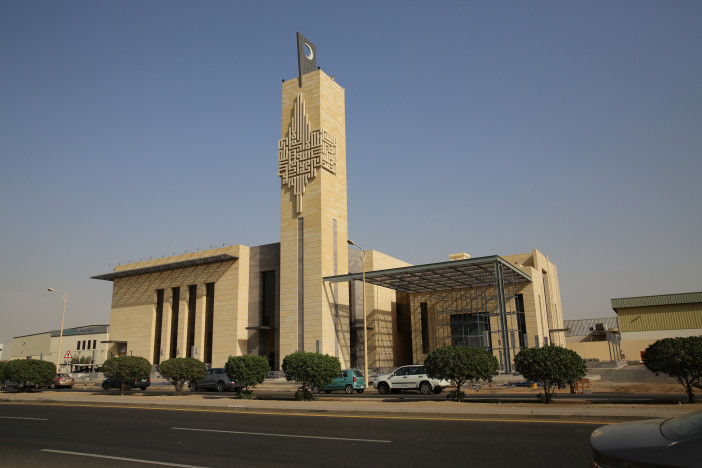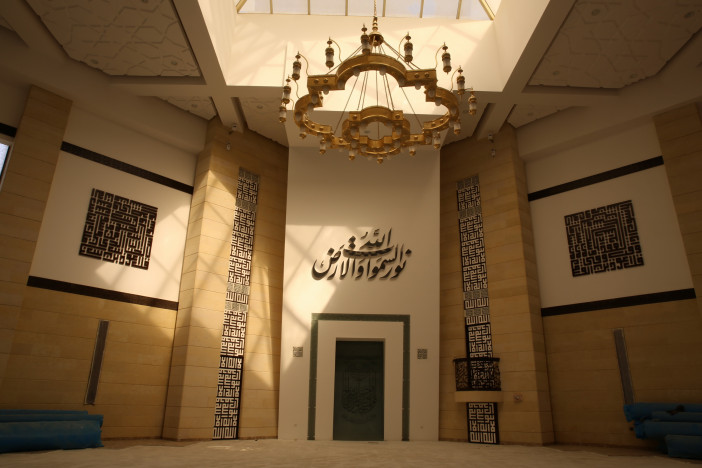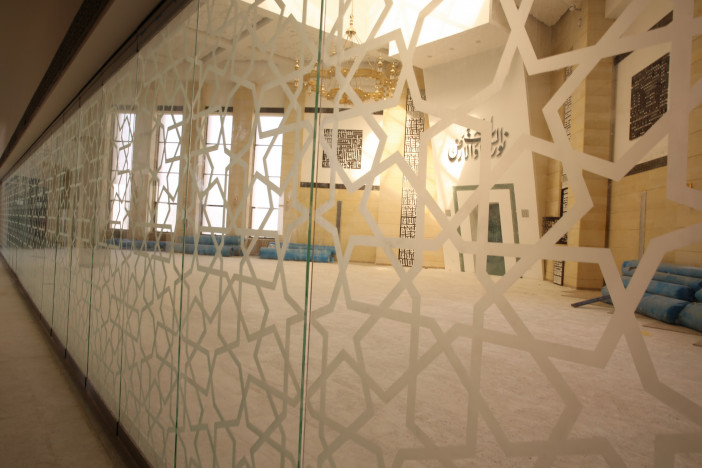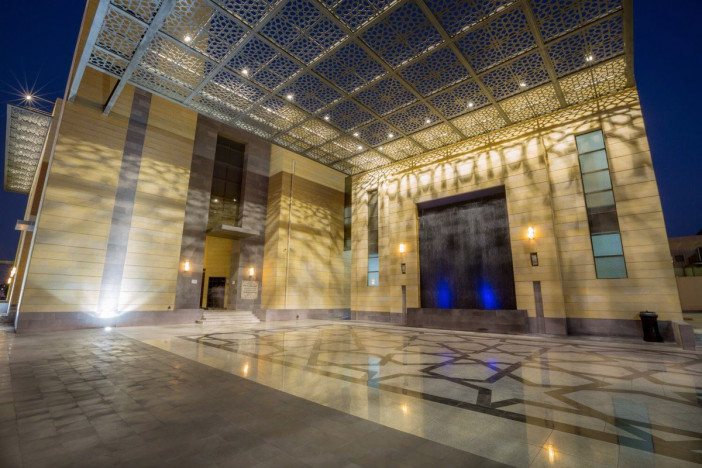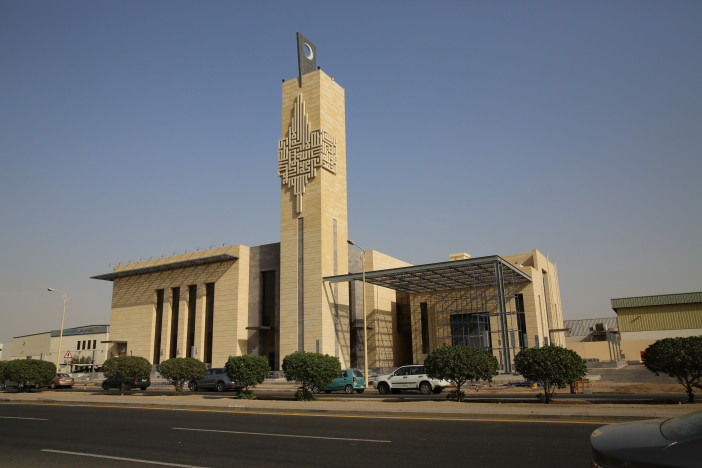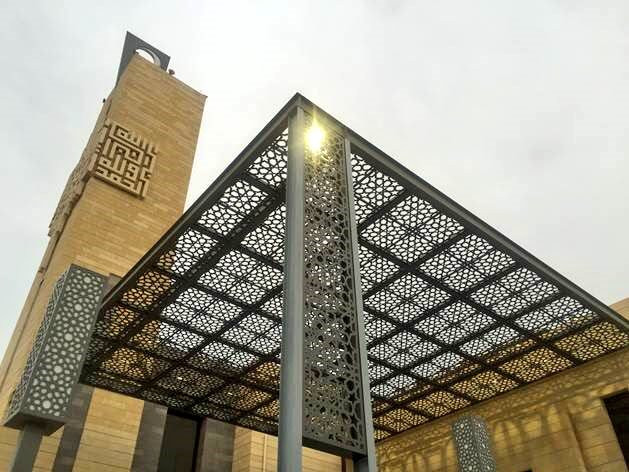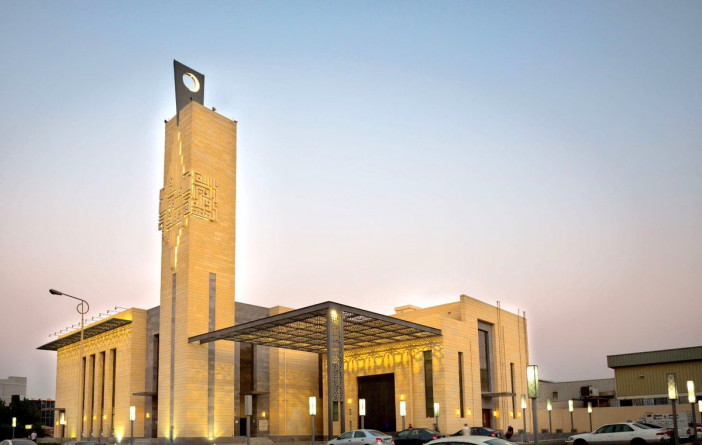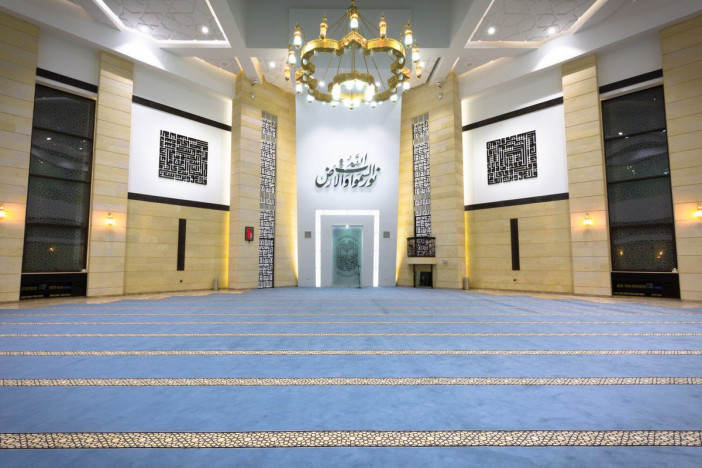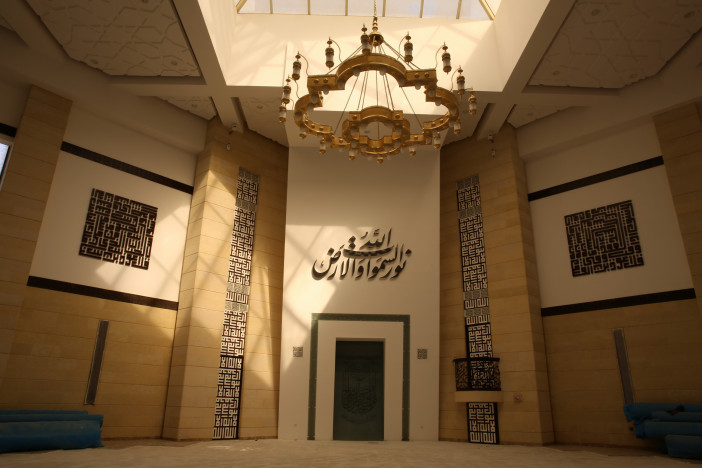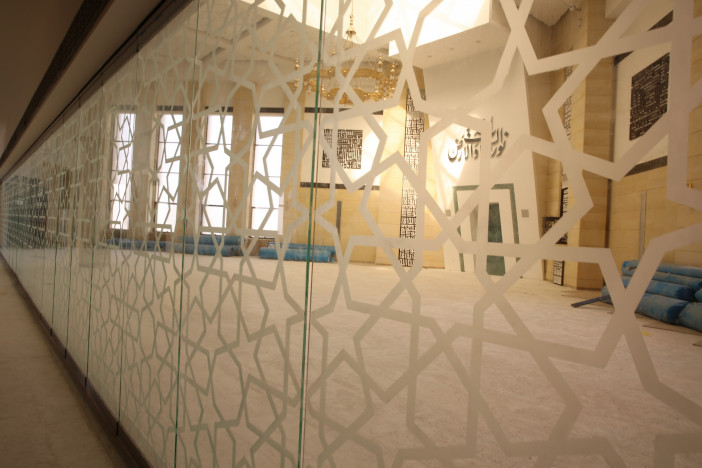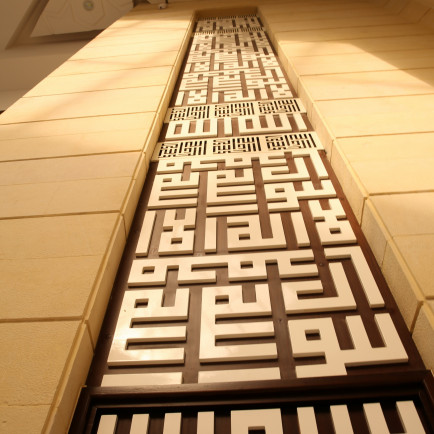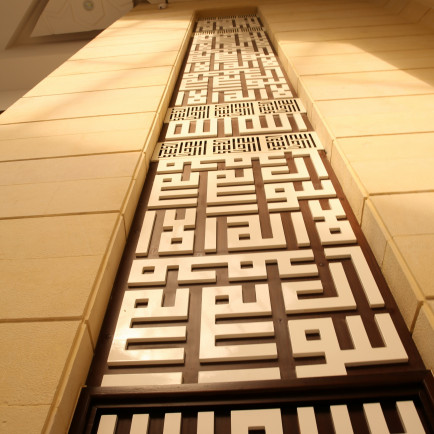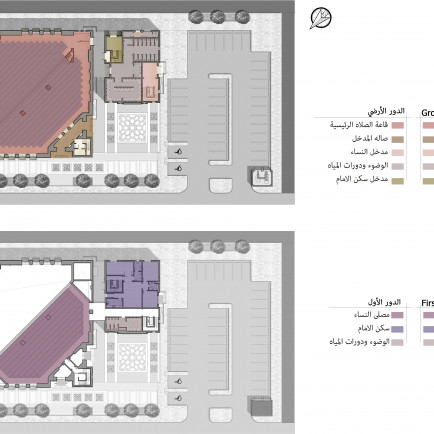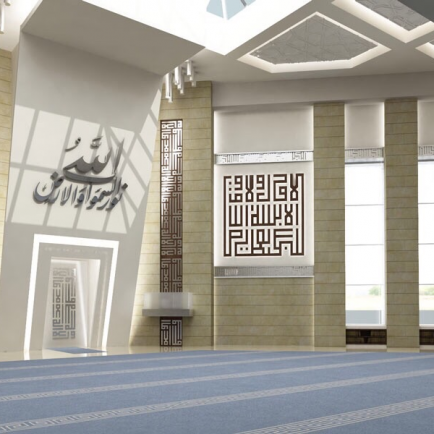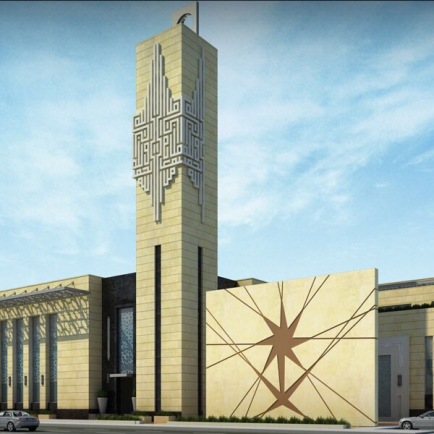Um Omar Mosque
Description
UM OMAR MOSQUE is located in Jeddah, Saudi Arabia. It is a 1200-square meter mosque consists of men prayer hall that accommodates 1200 worshippers and women prayer hall that accommodates 500 worshippers. It also has supporting facilities such as ablutions, entrance for women prayer area and housing for the imam and muezzin on 254 square meters. It also contains the external prayer area over an area of 330 square meters and footpaths, green spaces and landscaping areas over 1,153 square meters, as well as parking area of 1,095 square meters.
The mosque has two floors, the ground floor comprising the main prayer hall, entrance hall, entrance to women prayer area and ablution, toilets and the entrance to the Imam housing. The first floor contains women prayer areas, imam housing and ablution and toilets.
The prayer hall is square in shape. It forms the main block of the mosque. The designer re-defined the square by using its geometry in an unprecedented way in the design of mosques. Instead of orienting the side of the square towards Qibla, the designer has chosen instead to orient one of the diameters towards Mecca. Consequently, the corners of the square gained more importance than its sides. The designer then trimmed the corner of the square to carve out the main
entrance, providing a transitional space between the inside and the outside behind the minaret, which lies on the corner of the square. The mihrab was naturally located then at the opposite corner, with stairs behind it leading to the minbar, which takes the form of a circular balcony cantilevered at the side of the prayer hall. The diameter of the square that is parallel to the Qibla has divided the internal space of the prayer hall into two sections: the first has risen on two floors as a double volume space, while the other comprised a mezzanine floor for women praying that is structurally based on two columns corresponding to the main entrance.
The alignment of the square this way, with the diameter being parallel to the Qibla, has resulted in having the rows lined up in decreasing order from the diameter, meaning that the longest row was the diameter itself, whereas the shortest are the two closer to the square’s corners. This is totally uncharacteristic in mosque design. The tradition has been to design the first row, the closest to the mihrab, as the longest possible in order to comply with the Prophet Mohammad (PPUH) hadith that encourages worshippers to take the first row, as the best and where the most reward is.
The remaining two opposing corners of the square were designed as two side entrances, each of which in the shape of a small square. The corner of these little squares intersected with a large column that held a small space within and formed the end of a glass barrier that divided the larger square, or the main prayer hall, into two triangles.
The importance of this glass barrier dividing the men’s prayer hall into two parts lies in the fact that it aimed at the conservation of energy. When the mosque is not full in daily prayers, this glass barrier will be closed to save energy within the used section of the mosque. As such, this barrier glass works to define the used part of the prayer hall physically. At the same time it saves electrical energy needed to cool air, whereas in Friday prayer this barrier will be opened to enable the full use of the main prayer hall. Therefore, this mosque has been designed to consider principles of green architecture and requirements for energy consumption and conservation.
Next to the main square, which forms the men praying hall, lies services block attached to the mosque. It contains the entrance to the Imam and muezzin housing, as well as bathrooms for men and ablution area. At the rear of this block lies the entrance that leads to women prayer hall located at the upper floor accessed via stairs.
The design is characterized by the integral reciprocital relationship between the inside and the outside. This is achieved by covering the confined space between the main block and the main mosque on the one hand and between the minaret, which lies on the edge of the main of the mosque block, and the transition zone next to the main entrance. Thus, the design provides transitional spaces between the main block of the mosque, which is characterized by allowing light to provide amounts of shadow and light.
The design adheres to universal codes by complying to international principles to provide easy facilities for the needs of disabled or old people and those with special needs. All areas leading to the main entrances of the mosque were provided with a gentle ramp, in addition to stairs with rails for the elderly and people with special needs. Moreover, disable car parking close to the mosque were provided for people with special needs as well.
The upper floor is accessible via stairs across the bridge that connects the main block of the mosque and the services containing the entrance of women. To the left of the corridor leading to women prayer hall upstairs lies the ablution for women. On the same floor lies the housing the Imam, which is also accessible via a private staircase from the ground floor within the block for services. There exists also a bridge linking the women’s prayer hall with a minaret, located on the corner of the mosque square tower. This bridge extends over the open area between the minaret and the mosque, which casts shadows upon the main entrance of the mosque.
The mosque interior expresses a sense of outstanding thoughtful design. There exist homogeneity and integration, emphasized by the use of white surfaces and dynamic stone courses that have been used both in the inside and the outside. In addition, the use of internal surfaces and glass-clad with Islamic patterns and light-colors provokes admiration. Interior design attends to special details. Wood and natural colors have been used in addition to providing small cabinets for the Kuran to be kept under the windows. The choice of colors integrated with the amount of light allowed inside the main prayer hall casted a special spiritual atmosphere.
The facades and roofs of the mosque have demonstrated the designer’s ability to provide a balanced relationship between the blocks and materials used. This is also notable in the use of geometric motifs ranging between abstraction and compositional formations integrated with the block itself as noted in the minaret tower.
The design offers a model in the balanced relations between the block and architectural surfaces. It provides a medium solution between the traditional model of the mosque, comprising traditional elements like the minaret and the dome, and a contemporary interpretation. This design is characterized by not using the traditional form of the minaret, let alone using the dome at all. The design provides a complementary relationship by allowing light to access designated transitional places between inside and outside. Such a relationship is one of the aesthetics offered by this unique design of this mosque.
Details
Location
Jeddah 22237, Saudi Arabia
Worshippers
1700
Owners
Man of Goodwill
Architect Name
Spine Architecture and Engineering
Year of Build
2016
Area
1200 SQM
Drawings
Map
Description
UM OMAR MOSQUE is located in Jeddah, Saudi Arabia. It is a 1200-square meter mosque consists of men prayer hall that accommodates 1200 worshippers and women prayer hall that accommodates 500 worshippers. It also has supporting facilities such as ablutions, entrance for women prayer area and housing for the imam and muezzin on 254 square meters. It also contains the external prayer area over an area of 330 square meters and footpaths, green spaces and landscaping areas over 1,153 square meters, as well as parking area of 1,095 square meters.
The mosque has two floors, the ground floor comprising the main prayer hall, entrance hall, entrance to women prayer area and ablution, toilets and the entrance to the Imam housing. The first floor contains women prayer areas, imam housing and ablution and toilets.
The prayer hall is square in shape. It forms the main block of the mosque. The designer re-defined the square by using its geometry in an unprecedented way in the design of mosques. Instead of orienting the side of the square towards Qibla, the designer has chosen instead to orient one of the diameters towards Mecca. Consequently, the corners of the square gained more importance than its sides. The designer then trimmed the corner of the square to carve out the main
entrance, providing a transitional space between the inside and the outside behind the minaret, which lies on the corner of the square. The mihrab was naturally located then at the opposite corner, with stairs behind it leading to the minbar, which takes the form of a circular balcony cantilevered at the side of the prayer hall. The diameter of the square that is parallel to the Qibla has divided the internal space of the prayer hall into two sections: the first has risen on two floors as a double volume space, while the other comprised a mezzanine floor for women praying that is structurally based on two columns corresponding to the main entrance.
The alignment of the square this way, with the diameter being parallel to the Qibla, has resulted in having the rows lined up in decreasing order from the diameter, meaning that the longest row was the diameter itself, whereas the shortest are the two closer to the square’s corners. This is totally uncharacteristic in mosque design. The tradition has been to design the first row, the closest to the mihrab, as the longest possible in order to comply with the Prophet Mohammad (PPUH) hadith that encourages worshippers to take the first row, as the best and where the most reward is.
The remaining two opposing corners of the square were designed as two side entrances, each of which in the shape of a small square. The corner of these little squares intersected with a large column that held a small space within and formed the end of a glass barrier that divided the larger square, or the main prayer hall, into two triangles.
The importance of this glass barrier dividing the men’s prayer hall into two parts lies in the fact that it aimed at the conservation of energy. When the mosque is not full in daily prayers, this glass barrier will be closed to save energy within the used section of the mosque. As such, this barrier glass works to define the used part of the prayer hall physically. At the same time it saves electrical energy needed to cool air, whereas in Friday prayer this barrier will be opened to enable the full use of the main prayer hall. Therefore, this mosque has been designed to consider principles of green architecture and requirements for energy consumption and conservation.
Next to the main square, which forms the men praying hall, lies services block attached to the mosque. It contains the entrance to the Imam and muezzin housing, as well as bathrooms for men and ablution area. At the rear of this block lies the entrance that leads to women prayer hall located at the upper floor accessed via stairs.
The design is characterized by the integral reciprocital relationship between the inside and the outside. This is achieved by covering the confined space between the main block and the main mosque on the one hand and between the minaret, which lies on the edge of the main of the mosque block, and the transition zone next to the main entrance. Thus, the design provides transitional spaces between the main block of the mosque, which is characterized by allowing light to provide amounts of shadow and light.
The design adheres to universal codes by complying to international principles to provide easy facilities for the needs of disabled or old people and those with special needs. All areas leading to the main entrances of the mosque were provided with a gentle ramp, in addition to stairs with rails for the elderly and people with special needs. Moreover, disable car parking close to the mosque were provided for people with special needs as well.
The upper floor is accessible via stairs across the bridge that connects the main block of the mosque and the services containing the entrance of women. To the left of the corridor leading to women prayer hall upstairs lies the ablution for women. On the same floor lies the housing the Imam, which is also accessible via a private staircase from the ground floor within the block for services. There exists also a bridge linking the women’s prayer hall with a minaret, located on the corner of the mosque square tower. This bridge extends over the open area between the minaret and the mosque, which casts shadows upon the main entrance of the mosque.
The mosque interior expresses a sense of outstanding thoughtful design. There exist homogeneity and integration, emphasized by the use of white surfaces and dynamic stone courses that have been used both in the inside and the outside. In addition, the use of internal surfaces and glass-clad with Islamic patterns and light-colors provokes admiration. Interior design attends to special details. Wood and natural colors have been used in addition to providing small cabinets for the Kuran to be kept under the windows. The choice of colors integrated with the amount of light allowed inside the main prayer hall casted a special spiritual atmosphere.
The facades and roofs of the mosque have demonstrated the designer’s ability to provide a balanced relationship between the blocks and materials used. This is also notable in the use of geometric motifs ranging between abstraction and compositional formations integrated with the block itself as noted in the minaret tower.
The design offers a model in the balanced relations between the block and architectural surfaces. It provides a medium solution between the traditional model of the mosque, comprising traditional elements like the minaret and the dome, and a contemporary interpretation. This design is characterized by not using the traditional form of the minaret, let alone using the dome at all. The design provides a complementary relationship by allowing light to access designated transitional places between inside and outside. Such a relationship is one of the aesthetics offered by this unique design of this mosque.


